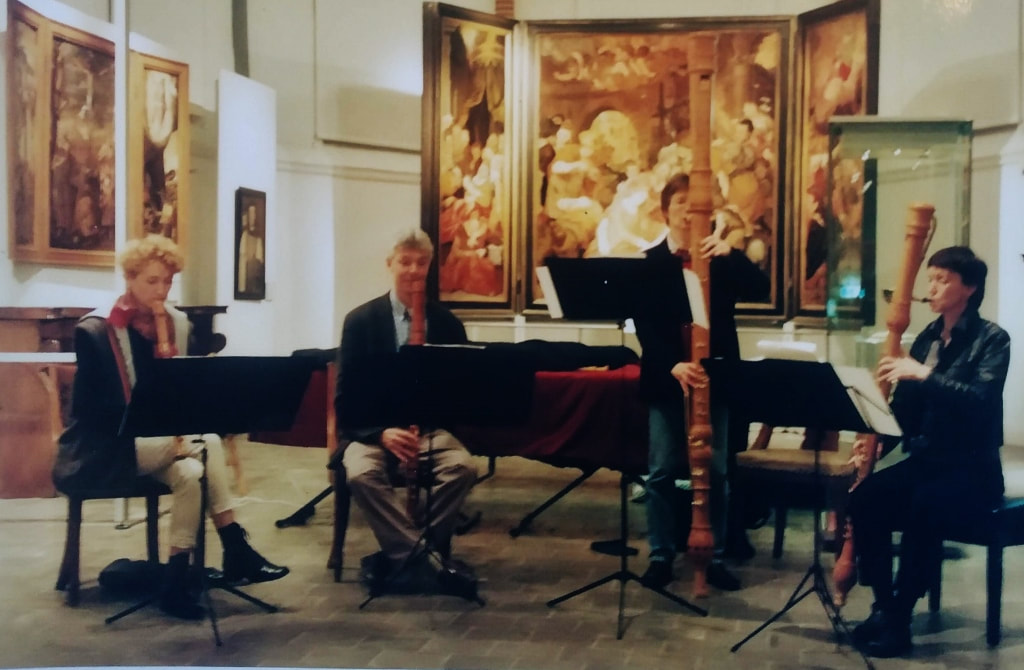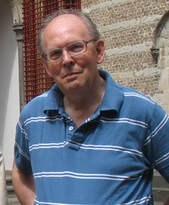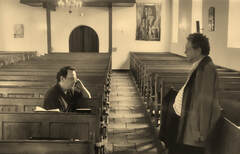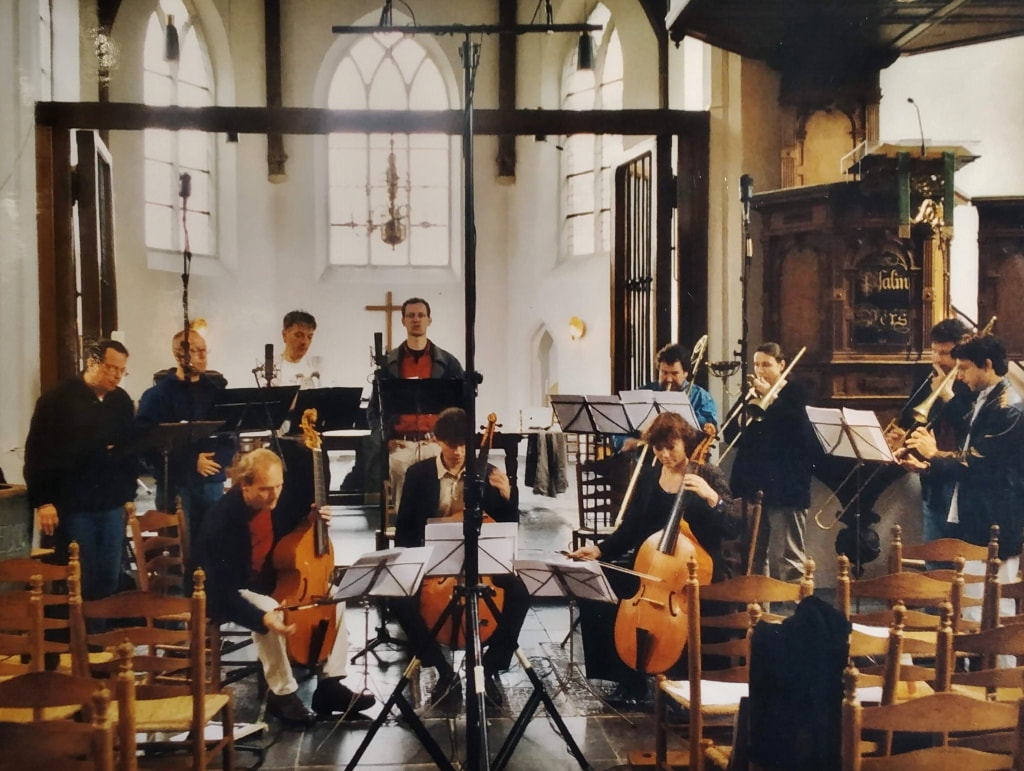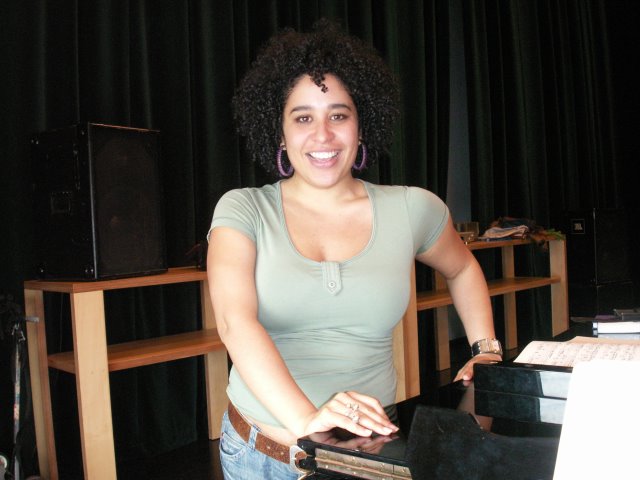2001-2003 the way to 'fame'
2001
2001 Triptica
was a ‘conceptual program’ Egidius performed in collaboration with the Dutch Recorder Ensemble Brisk. Its architecture followed the symmetry of a renaissance polyptych like the Gent Agnus Dei by Vann Eyck. The centre piece was commissioned by us: a Retrograde on a text by Anthonius de Roovere. Thus the symmetrie was assured, having the word Maria right in the centre, we build our ‘triptych’, which was in fact a nine-panel, our three tryptichs put toghether, like this:
was a ‘conceptual program’ Egidius performed in collaboration with the Dutch Recorder Ensemble Brisk. Its architecture followed the symmetry of a renaissance polyptych like the Gent Agnus Dei by Vann Eyck. The centre piece was commissioned by us: a Retrograde on a text by Anthonius de Roovere. Thus the symmetrie was assured, having the word Maria right in the centre, we build our ‘triptych’, which was in fact a nine-panel, our three tryptichs put toghether, like this:
Note that Bart Visman is the pupil of Daan Manneke. Manneke composed the first verse of the Egidius lament, Visman the second verse. We asked both Manneke and Visman to write a new composition on a text dealing with Pan. They did. Splendidly.
we performed Triptica in Kloveniersdoelen (Middelburg), 't Hof (Dordrecht), Provadja (Alkmaar), Catharina Museum (Gouda) together with Henk van Os and Waalse kerk (Amsterdam)
we performed Triptica in Kloveniersdoelen (Middelburg), 't Hof (Dordrecht), Provadja (Alkmaar), Catharina Museum (Gouda) together with Henk van Os and Waalse kerk (Amsterdam)
|
2001 Schubert tussen hemel en aarde (Schubert in between heaven and earth)
Fortepianist Arthur Schoonderwoerd and I met already when I was still a music teacher at a high school in Brielle, Arthur was a pupil of that school and accompanied the school cabaret of which I was in charge. Being later on a renowned professional pianist he invited us to join him in a Schubert program together with the equally renowned Dutch soprano Johannette Zomer. Schubert was fond of men-only ensembles a cappella and in combination with forte-piano (Arthur played on a beautiful Graf copy). In 2001 we organized a concert serie with three venues: Leiden, Amsterdam and Utrecht, and we recorded the program. In 2003 we sang Schubert in the Radovlice Festival (Slovenia), in 2004 in Antwerp (Festival of Flanders), in 2006 in the famous Festival de Saintes, where Carolyn Sampson joined us, and in Schiedam (Westvest church). In 2014 Arthur invited us to his own Music Festival near Besançon to sing this wonderful program again. 2001 Nocturne Triste
A program we regrettably only performed twice. Having a marvelous Spanish soprano as the ‘fifth member’ of the quartet, we couldn’t resist to make a melancholic and dark program for the Museum Night in Utrecht. Maria Luz Alvarez excelled in Sephardic songs, and we had the honour to accompany her together with La Sfera Armoniosa (Mike Fentross-theorbo and guitar, Paulina van Laarhoven-viol, and Adriàn Rodriquez van der Spoel-percussion). |
We even forgot to take pictures of this great event, but you may listen to the last piece of the program here; Recording by Bert van Dijk for KRO Radio
|
|
2001 Tielman Susato Het ierste en tweetste Musyck Boexken
In 2001 it was 450 years ago that printer/composer Tylman Susato published his two muziekboexkens (music books), containing 55 polyphonic songs in Dutch with the sole aim to emancipate the Dutch language as a vehicle for arty songs and to prove that this language was equally fitted for the job as French and Italian. His muziekboexkens belong to the great polyphonic treasures of the Low Countries, and are as in important as the Gruuthuse mansucript, the Antwerp Songbook, the Souterliedekens by Clemens, Canciones Sacrae by Sweelinck and the Pathodica by Huygens. The two volumes features, apart from some local composers, important names as Vinders, Clemens non Papa and Appenzeller. Never before an integral recording of this collection was made. Thanks to several generous subsidies and a collaboration with MuziekGroep Nederland (not existing anymore) we were able to record them and have no less than four concert series during the years 2001-2002 to present practically all the songs to our public. (One of the series was in the Dutch Network for Early Music.) The concerts were given by the Egidius Kwartet and its newly established Egidius Consort: Saskia Coolen (viol & recorders), Johannes Boer (viol) and Erik Beijer (viol and percussion). In the same year the recording was made, the double-cd was released in 2002. we used the impeccable modern edition by Timothy McTaggart in Recent Research of the Music of the Renaissance, nr 108 |
|
2001 Fortune hélas. Regretz chanson by Josquin des Prez
For the Utrecht Early Music Festival and Laus Polyphoniae in Antwerp we prepared a program around the ‘regretz chansons’ by Josquin des Prez. It was my first collaboration with the eminent musicologist and Josquin specialist Jaap van Benthem. Van Benthem had guided me amicably through my first transcription attempts in the late 90’s, now we exchanged views on text underlay and we found some exiting solutions for scoring top hits like Dulces exuviae. In this program the rather lowish topline was sung by mezzo-soprano Karin van der Poel. |
|
2001 Het kindeken Jezus in Vlaanderen (The Christ-child in Flanders) The first of a great many of Christmas programs sung by Egidius consisted of music by composers around Bruges in the 15th and 16th century. Guillaume Dufay, Gilles Binchois, Jacob Obrecht, Antoine Busnoys, Lupus Hellinck, Arnold von Bruck, Gheerkin de Hondt, Benedictus Appenzeller and Clemens non Papa and a number of anonymous compositions found in manuscripts related to this town. I combined it with a ancient tradition; to set the Christmas scene in the landscape and society of medieval and renaissance Flanders. (see the so called Bladeleyn retable by Rogier van der Weyden). Therefor I choose the magnificent and moving text by Felix Timmermans that intertwined the polyphonic pieces. This text was superbly read by a native Flemish colleague ad friend: René van Laken.
|
2002
CD 4: Tielman Susato, het ierste en tweetste musyck boexken

In the midst of our four series dedicated to the Musyck Boexkens of Susato the double CD was released, beautifully designed by Roeland Gerritsen and Cornelius van Velsen for NM Classics. It had two booklets, one with liner notes (in Dutch, English, French and Spanish), the other provided all the texts, annotated by Johan Oosterman and translated in English by Timothy McTaggart. The CD’s followed the original order of Susato (mode-wise). We were very proud of this monumental production. The biggest compliment I got for the enormous work was given by Paul Van Nevel (Huelgas Ensemble), my mentor, who, when introducing me to someone, in multiple occasions formulated his presentation always as follows: “This is Peter de Groot, one of my singers. He recorded Susato. Very very well!”
Recording: Mijnsheerenland, Laurentius Church, august 2001.
Producer: Ivar Munk. Engineer: Arjan de reus. Mastering: BNF Hilversum.
With: Katelijne van Laethem -soprano, Paul van den Bemt, -tenor.
Egidius Consort: Margriet Tindemans -treble viol & recorder, Johannes Boer -alto viol & recorder, Erik Beijer -tenor viol & percussion, Saskia Coolen -bass viol & recorder.
Oltremontano: Jean-Pierre Canihac, cornetto, Josué Meléndez, cornetto, Simen van Mechelen, alto trombone, Dominique Lortie -tenor trombone, Wim Becu -bass trombone
Although the distriubution of this CD by NM Classics stopped, and although the CD is still available at bol.com, I still have a great amount of this album on stock. One may order one or more copies to a very modest price (10 € per copy + postage) by writing me an e-mail. Just click here.
Recording: Mijnsheerenland, Laurentius Church, august 2001.
Producer: Ivar Munk. Engineer: Arjan de reus. Mastering: BNF Hilversum.
With: Katelijne van Laethem -soprano, Paul van den Bemt, -tenor.
Egidius Consort: Margriet Tindemans -treble viol & recorder, Johannes Boer -alto viol & recorder, Erik Beijer -tenor viol & percussion, Saskia Coolen -bass viol & recorder.
Oltremontano: Jean-Pierre Canihac, cornetto, Josué Meléndez, cornetto, Simen van Mechelen, alto trombone, Dominique Lortie -tenor trombone, Wim Becu -bass trombone
Although the distriubution of this CD by NM Classics stopped, and although the CD is still available at bol.com, I still have a great amount of this album on stock. One may order one or more copies to a very modest price (10 € per copy + postage) by writing me an e-mail. Just click here.

Here below some samples of the Susato double-CD.
Enjoy !
Enjoy !
|
from book 1
|
from book 2
|
Recording pictures
|
2002 Kurt Weil : Sieben Todsünden
We made our Rotterdam Doelen debut with the Rotterdam Philharmonic, HK Gruber conductor, Sona MacDonald -soprano. Egidius sang Weil's Sieben Todsünden four years later with Nederlands Blazers Ensemble (NBE), with Tania Kross singing the role of Anna. Later in our career we quite often sang ‘Völlerei” from this piece a cappella. |
|
2002 Heilige Vormen (Sacred 'forms' i.g. La sagrada forma, the Holy Sacrament)
Two months later: our Amsterdam Concertgebouw debut. A program made in collaboration with the Dutch writer Hans Maarten van den Brink. Music by Rogier, De Rore, Manchicourt, Sweelinck, Busnois, Visman, Manneke. |
|
2002 Lully: Le Bourgeois gentilhomme
Same month: again Vredenburg (Utrecht). With Combattimento Consort (Jan Willem de Vriend conductor) and Lieuwe Visser (in the role of the Mufti). We also sang Telemann : Klingende Geographie In 2005 we sang Lully's Bourgeois gentilhomme-scene again, when Jan Willem de Vriend was guest conducting the Radio Kamer Orkest. Eva Buchman stage director, Jan Alofs as Mufti. |
click to enlarge
|
|
2002 'Mon souvenir': The Chansonnier of Lauweryn van Watervliet
The study the Dutch songs in the facsimile score of the Lauweryn van Watervliet Chansonnier (c. 1515) triggered my interest in pre-humanistic text underlay. I had vivid discussions about it with Jaap van Benthem, and persuaded my fellow quartet members to dedicate a whole program on this remarkable song book, presenting some French chansons, all the Dutch songs and some bi-lingual motets. Johan Oosterman ivited me even to give a lecture about it at Radboud University Nijmegen. Between 2002 and 2007 we performed the program 14 times. Premiere was in the new Concert Hall of Bruge (B), KLARA recorded it. In 2003 we sang our Lauweryn program in the little village of its origin: Watervliet. A double CD appeared in 2006. |
2002 Divina res es musica. Erasmus on Music.
The Dutch historian and writer Chris van der Heijden invited us to Valencia where an exhibition on Erasmus was held in the magnificent Library of the Monsaterio San Miguel de los Reyes. Erasmus made during his lifetime quite a lot of interesting remarks on the music and the habits of the musicians of his time. The program contained polyphony from The Netherlands, Germany, France and England. We were in the company of the Japanese soprano Eri Takahashi and the texts of Erasmus were read with ardor by the Spanish actor Rafael Taibo.
The Dutch historian and writer Chris van der Heijden invited us to Valencia where an exhibition on Erasmus was held in the magnificent Library of the Monsaterio San Miguel de los Reyes. Erasmus made during his lifetime quite a lot of interesting remarks on the music and the habits of the musicians of his time. The program contained polyphony from The Netherlands, Germany, France and England. We were in the company of the Japanese soprano Eri Takahashi and the texts of Erasmus were read with ardor by the Spanish actor Rafael Taibo.
2003
|
2003 Mon petit cueur (Gheerkin de Hondt)
Already in the first years of my researches for Egidius, in the late nineties, I met Véronique Roelvink, at that time a musicology student in Utrecht, about to write a thesis on Gheerkin de Hondt. It was an immediate click. Véronique provided me her transcriptions of all the chansons composed by Gheerkin and some motets. Beautiful music. In great harmony we revised some text underlay issues and I made a program with just the music of this so called ‘Kleinmeister’, working in Den Bosch for the Fraternity of the Swan, also known as the Fraternity of Our Lady (an institution that still exists!), and who was nicknamed ‘harteken’ (Little heart), hence the title of the program: Mon petit cueur. It coincided with the publiciation of Véroniques book on the Fraternity: Ghegeven den Sangeren. By the way, we ususally adressed to Véronique, respectfully and with admiration, as 'Mrs De Hondt". |
Véronique Roelvink
|
Premiere in Muncipal Museum of Zutphen
|
cd 5: Ghegeven den sangeren (given to the singers)

An extensive book on the musical aspects of the Fraternity of Our Lady appeared. Véronique Roelvink had researched the archival material in Den Bosch and gave a full and detailed display of the customs and choir books of the cathedrals respectable Institution. In the back flap of the book a 25 minute cd of Egidius was added to give some examples of the subject of the book.
Véronique Roelvink, Gegeven den sangeren. Meerstemmig muziek bij de Illustre Lieve Vrouwe Broederschap te ’s-Hertogenbosch in de zestiende eeuw, ’s-Hertogenbosch, Adriaan Heinen Uitgevers, 21 november 2002. ISBN 9070706555 One may order the book via THIS link.
Egidius Kwartet with Barbarba Bordon -soprano and Paul van den Bemt -tenor.
Recording 22 april 2002 Den Bosch, St. James church
Producer: Erik Beijer
Véronique Roelvink, Gegeven den sangeren. Meerstemmig muziek bij de Illustre Lieve Vrouwe Broederschap te ’s-Hertogenbosch in de zestiende eeuw, ’s-Hertogenbosch, Adriaan Heinen Uitgevers, 21 november 2002. ISBN 9070706555 One may order the book via THIS link.
Egidius Kwartet with Barbarba Bordon -soprano and Paul van den Bemt -tenor.
Recording 22 april 2002 Den Bosch, St. James church
Producer: Erik Beijer
|
The last track on the little cd is Gheerkin's Benedicite, which he probably wrote for the Fraternity in 1540. It was a custom to say or sing this prayer before the solemn and annual Fraternity banquet. No other composer than Gheerkin ever set this text to music.
|
CD 6: ronsard et les néerlandais

It took two years to wait for the release of our Ronsard CD, already recorded in the beginning of 2001. On the cover of the CD one sees a sensuous detail of an anonymous painting in the collection of the Musée des Beaux-arts in Rennes (F): La femme entre les deux âges. Thanks to a generous gift of our friends, the Egidius-ghesellen, we were able to acquire the rights.
Recording; January, March and April 2001, Dutch Reformed Church Bunnik
Producer: Erik Beijer
Production: Paul Janse for Et’cetera
Design : Charlotte Boersma
Text translations : Donald Bentvelsen
Recording; January, March and April 2001, Dutch Reformed Church Bunnik
Producer: Erik Beijer
Production: Paul Janse for Et’cetera
Design : Charlotte Boersma
Text translations : Donald Bentvelsen
|
2003 Isaac-Bach-Manneke
We were invited to open the Organfestival Holland 2003. Since we had established a firm relationship with Daan Manneke in the previous years I came up with the idea to present him as a good example of a ‘contemporary polyphonist’, thus making a wide-span line: Isaac-Bach-Manneke. We performed Heinrich Isaac’s six part Missa Solenelle, according to an old alternatim principle, in use throughout the 16th and even 17th century, with the American organist and improvisation specialist William Porter. Daan Manneke wrote for the occasion a new set of hymns (Cinque Canti) for the quartet, based on an ambrosian idiom. In the year 2004-2005 we performed the program several times (including Paris) with Ton Koopman. For the record: this program was the first concert with our new tenor; Marco van de Klundert. |
|
2003 Happy Humanists (Moralia by Jacobus Gallus)
Happy humanists, containing a selection of the latin moralia by Jacobus Gallus, was made for the 2003 Laus Polyphoniae (Antwerp). Rich harmonies, inventive wordpainting and an unmistakable sense of humor are the characteristics of these compositions, which were in fact madrigals, but Gallus prefered to call tehm moralia to avoid all confusions with the, to his taste too sensuous, genre of madrigals. I combined the moralia with texts coming from the Laus stultitiae (Praise of Folly) by Desiderius Erasmus, read with enthusiasm by Tamar Brüggemann, who, for the occasion, was dressed up as the jester of service. |



